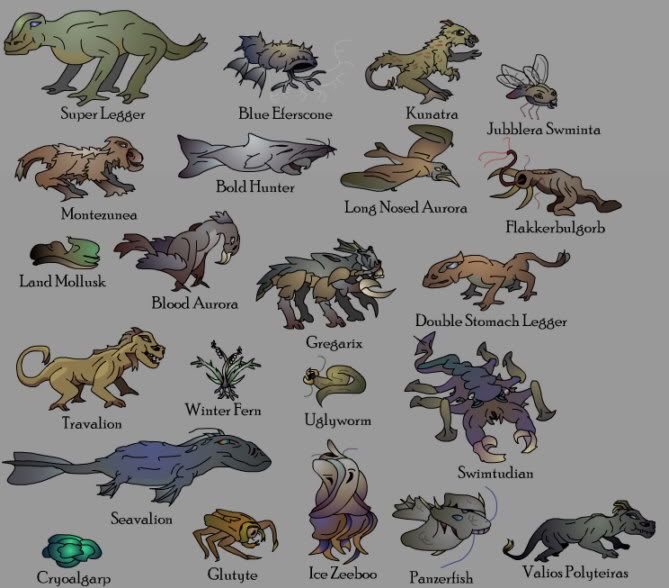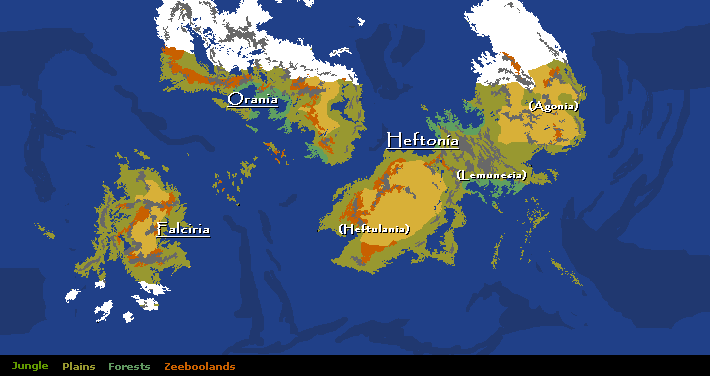The continent known as Heftulania collided with the much older continent of Agonia. The result has been called 'Heftonia'. Most of the Lemunesian islands were squeezed out of existence by this point, and vast mountain chains rose in their place.

Heftonia was obviously the largest and most diverse continent. The survivors of Agonia's unique species were finally able to spread out to new territory, which they did very successfully, and just in time as glaciers soon covered half of former Agonia.
Saaranixes and
Flevrytes spread in the opposite direction. Most species were able to co-exist without too much conflict.
Meanwhile evolution was not standing still, and this continent gave rise to several new varieties. The
Jafankunea, the last survivor of the Kakoo family, evolved into insect-hunting
Kunatras and also the cold-adapted
Montezuneas. The latter were especially common in the cold northern latitudes where no predators could follow.
Talking of which, the
Ice Zeeboo first appeared in the north and was the only plant able to survive amongst the freezing mountains and glaciers. Meanwhile the
Rock Zeeboos finally met their long-lost cousins the
Tougher Zeeboos.
The
Chrontrevalion, the only land carnivore to survive the last era, gave rise to the
Valios Polyteiras and
Travalions. These hunters were fierce rivals with overlapping lifestyles. Travalions were faster (in fact, the fastest animal alive, at least in a short sprint) and stronger, and able to live further inland. The Valios Polyteira was a more social species with more efficient digestion, allowing more of them to survive from the same amount of food. Neither species had the upper hand, but both did quite well, as they were the only fast and well-armed carnivores around.
Pro-Leggers and
Ol Scrapers were still around, living alongside the new
Super Leggers and
Double Stomach Leggers. The Super Leggers were the biggest land animals alive at the time, and once grown to full size they could enjoy peaceful lives eating fruit in the forests.
Double Stomach Leggers, as the name suggests, had stomachs that allowed them to nibble on all sorts of roots and shoots. They also had sharper eyes for spotting an ambush. They were very successful in the equatorial regions, but like the other Leggers they could not survive in the colder regions to the north and south.
The
Uglybug family did well, especially the new
Uglyworm which replaced the ancient Leafworms in most areas.
Flakkerbulgorbs replaced the older
Hunter Bulgorb with a more efficient way of catching insects, which was especially useful from the cover of burrows or dense vegetation, but their fearsome jaws were not enough to protect them from inquisitive gangs of Travalions and Valios Polyteiras.
Finally, the honey-producing
Glutyte appeared here and had completely replaced the ancient
Hiborytes on this continent by the end of this era.
Subterradids were clearly not upset by all the newcomers, as the fossil record shows they had huge populations of their own, mainly living out in the dry plains.
Notable Animals:
Subterradids, Kunatras, Montezuneas, Glutytes, Uglyworms, Flakkerbulgorbs, Cephrivervalions, Pre Leggers, Super Leggers, Double Stomach Leggers, Ol Scrapers, Jubblerus Sensicas, Black Auroras, Saaranixes, Felvrytes, Travalions, Valios Polyteiras, Tougher Zeeboos.
Notable Plants:
Novo Tranels, Rock Zeeboo, Ice Zeeboo, Chungus, Woody Fanels, Weak Ferns, Winter Ferns, Parasitic Driftseeds, Proto-Moss, Super Lichen, Ground Fuzz










